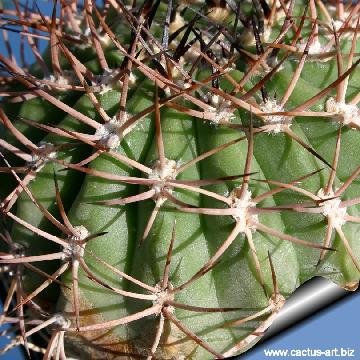Donate now to support the LLIFLE projects.
Your support is critical to our success.
Your support is critical to our success.
Acanthocalycium thionanthum var. copiapoides
nom. nud. Catalog name (Jörg and Brigitte Piltz): field number P54 Quebrada de Cafayate, Salta, Argentina 1600m
Family: CACTACEAE
nom. nud. Catalog name (Jörg and Brigitte Piltz): field number P54 Quebrada de Cafayate, Salta, Argentina 1600m
Family: CACTACEAE
Accepted Scientific Name: Echinopsis thionantha (Speg.) D.R.Hunt
Bradleya 5: 92 (1987)

Echinopsis (Acanthocalicium) thionantha var. copiapoides.
The variety name ''copiapoides''means similar to ''copiapoa'' and it was originally applied to a short spined form with grey-green epidermis of this very variable taxon.
The variety name ''copiapoides''means similar to ''copiapoa'' and it was originally applied to a short spined form with grey-green epidermis of this very variable taxon.
Synonyms:
See all synonyms of Echinopsis thionantha
back
Accepted name in llifle Database:Echinopsis thionantha (Speg.) D.R.Hunt
Bradleya 5: 92 (1987)
Synonymy: 19
- Echinopsis thionantha (Speg.) D.R.Hunt
- Acanthocalycium thionanthum (Speg.) Backeb.
- Echinocactus thionanthus Speg.
- Lobivia thionantha (Speg.) Britton & Rose
- Acanthocalycium thionanthum var. brevispinum n.n.
- Acanthocalycium catamarcense F.Ritter
- Lobivia thionantha var. catamarcensis (F.Ritter) Rausch
- Acanthocalycium griseum Backeb.
- Acanthocalycium thionanthum var. copiapoides Piltz
- Acanthocalycium thionanthum var. munitum (Rausch) J.G.Lamb.
- Acanthocalycium minutum F.Ritter
- Lobivia thionantha var. munita Rausch
- Echinopsis brevispina (F.Ritter) H.Friedrich & G.D.Rowley
- Acanthocalycium brevispinum F.Ritter
- Lobivia thionantha var. brevispina (F.Ritter) Rausch
- Echinopsis chionantha (Speg.) Werderm.
- Acanthocalycium chionanthum (Speg.) Backeb. in Backeb. & F.M.Knuth
- Echinocactus chionanthum Speg.
- Lobivia chionantha (Speg.) Britton & Rose
back

Acanthocalycium thionanthum var. copiapoides Photo by: Valentino Vallicelli

Acanthocalycium thionanthum var. copiapoides Photo by: Valentino Vallicelli

Acanthocalycium thionanthum var. copiapoides Photo by: Valentino Vallicelli

Acanthocalycium thionanthum var. copiapoides Photo by: Cactus Art

Acanthocalycium thionanthum var. copiapoides Photo by: Cactus Art
Send a photo of this plant.
The gallery now contains thousands of pictures, however it is possible to do even more. We are, of course, seeking photos of species not yet shown in the gallery but not only that, we are also looking for better pictures than those already present. Read More...
The gallery now contains thousands of pictures, however it is possible to do even more. We are, of course, seeking photos of species not yet shown in the gallery but not only that, we are also looking for better pictures than those already present. Read More...
| Your Actions | |
|---|---|
| Back to Acanthocalycium index | |
| Back to Cactaceae index | |
 |
Back to Cacti Encyclopedia index |








